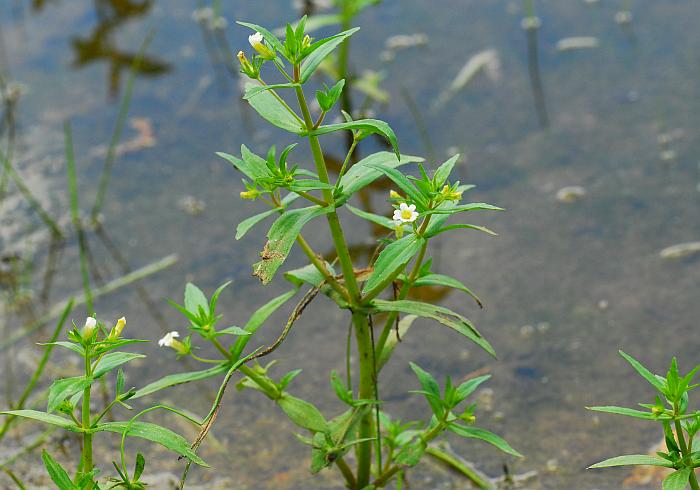Gratiola neglecta Torr.
Clammy Hedge Hyssop

Native
CC = 4
CW = -5
MOC = 60
© SRTurner
Gratiola neglecta Torr.Clammy Hedge Hyssop | |
 |
Native CC = 4 CW = -5 MOC = 60 |
© SRTurner |
|
Family - Plantaginaceae Habit - Fibrous-rooted annual forb. Stem - Erect, to 40 cm, usually branched, densely pubescent with glandular hairs, especially toward the tips.
Leaves - Opposite, simple, sessile. Blades 1-6 cm long, linear to oblanceolate, those of the uppermost leaves sometimes elliptic-obovate, those of the main leaves broadest near the midpoint, narrowed basally, sharply pointed at the tip, the margins with few to several, shallow to moderately coarse, sharp teeth, the surfaces sparsely to moderately short-hairy, sometimes appearing glabrous or nearly so.
Inflorescence - Inflorescences axillary, the flowers 1 or 2 per node, the flower stalks short to elongate; bractlets 2, 3-6 mm long, closely subtending the calyx.
Flowers - Perfect. Calyces deeply 5-lobed, 3-7 mm long, glabrous or more commonly glandular-hairy. Corollas bilabiate, 5-lobed, but sometimes appearing nearly 4-lobed, 7-10 mm long, tubular to somewhat trumpet-shaped, the tube longer than the lobes, usually slightly arched upward, white or cream-colored to pale yellow externally, with dark purple to dark brownish purple venation, white to pinkish or light yellow in the throat, hairy on the inner surface of the upper side, the upper lip very shallowly notched or 2-lobed, the lower lip with 3 deeper lobes, these usually shallowly and broadly notched, the lobes usually white, often becoming purplish-tinged upon drying. Fertile stamens 2, not exserted, staminodes usually present, appearing as a pair of antherless filaments. Style 1, not exserted, forked near the tip, the short branches flattened and broad (appearing similar to a pair of lips).
Fruits - Capsules, ovoid, 2-locular, 3-7 mm long, about as long as the calyces. Seeds numerous, 0.5-0.9 mm long, more or less cylindric to somewhat conic, usually appearing several-angled, the surface yellowish brown to brown, with a network of prominent ridges arranged into vertical ranks.
Flowering - May - October. Habitat - Pond margins, sloughs, streambanks, fens, marshes, crop fields, mud flats, wet disturbed areas, sometimes in shallow standing water. Origin - Native to the U.S. Lookalikes - G. virginiana, Lindernia dubia. Other info. - This little wetland species occurs across most parts of Missouri. Its wider distribution includes large swaths of the continental U.S., especially in the Midwest, Northeast, and Northwest. Being a wetland plant, it is scarce or absent from more arid regions of the country. Photographs taken at Pea Ridge Conservation Area, Washington County, MO, 6-8-2013, Pacific Palisades Conservation Area, Jefferson County, MO, 5-18-2019, and Otter Slough Conservation Area, Stoddard County, MO, 6-10-2023 (SRTurner). |